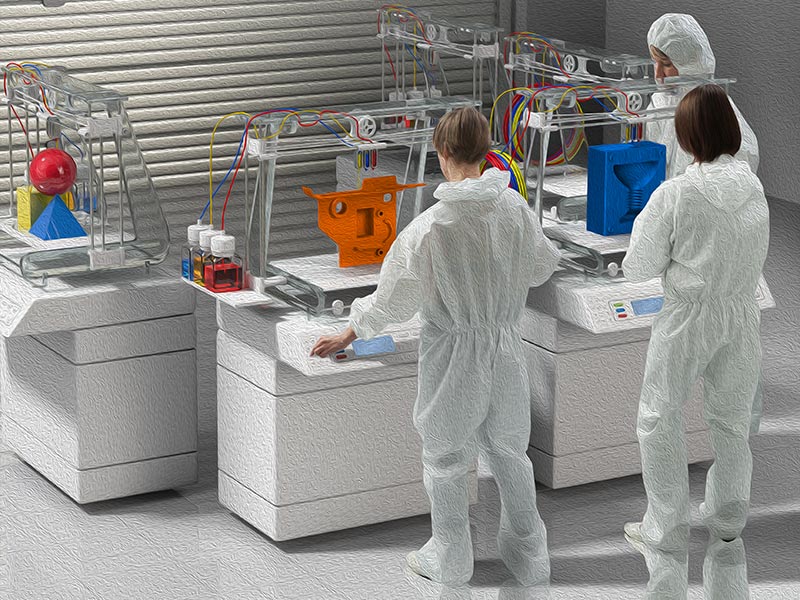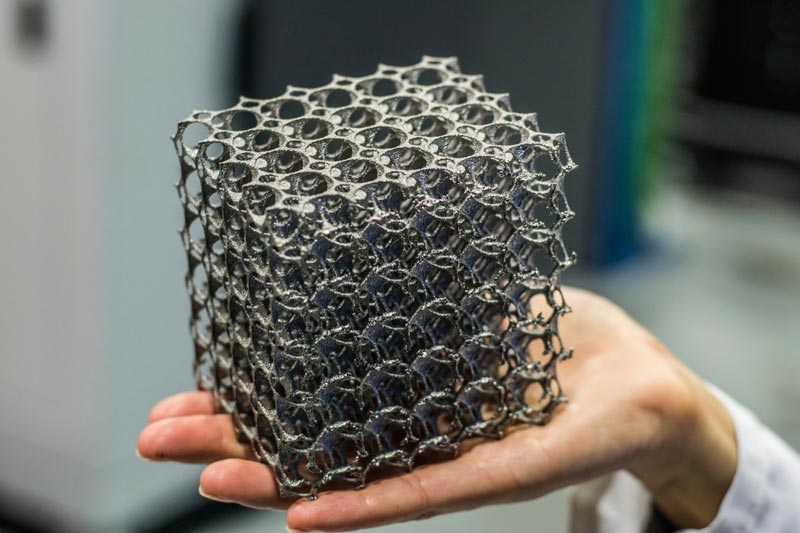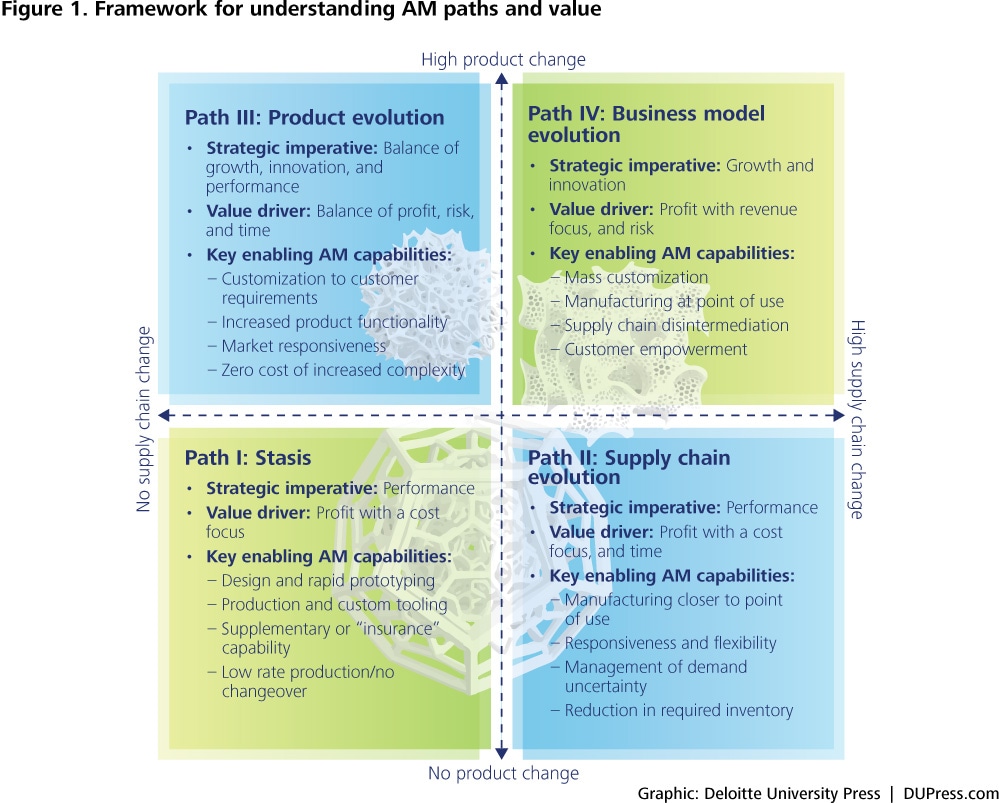3D opportunity in tooling has been saved

3D opportunity in tooling Additive manufacturing shapes the future
08 April 2014
The use of additive manufacturing to fabricate tooling can not only reduce lead times and costs, but also improve functionality and enhance the ability to customize.

Additive manufacturing: Four tactical paths
Additive manufacturing (AM), more popularly known as 3D printing, describes a group of technologies used to produce objects through the addition of material rather than its removal. AM first became commercially viable in the mid-1980s. Its first widespread applications were in the production of prototypes, models, and visualization tools. More recently, however, advances in printer and materials technology have allowed AM to expand to other applications such as tooling and end-user part production.1 AM is used in many industries, including aerospace and defense, automotive, consumer products, industrial products, medical devices, and architecture. The overall market size for the AM industry was estimated at $2 billion in 2012, and it is growing at a compound annual growth rate (CAGR) of 14.2 percent.2
Want to learn more about 3D printing?
Visit the 3D Opportunity collection
Register for our upcoming course
The article 3D opportunity: Additive manufacturing paths to performance, innovation, and growth provides an overall perspective on the impact of AM, outlined in the framework illustrated in figure 1.3
AM is an important technology innovation whose roots go back nearly three decades. Its importance is derived from its ability to break existing performance trade-offs in two fundamental ways. First, AM reduces the capital required to achieve economies of scale. Second, it increases flexibility and reduces the capital required to achieve scope.
Capital versus scale: Considerations of minimum efficient scale shape the supply chain. AM has the potential to reduce the capital required to reach minimum efficient scale for production, thus lowering the barriers to entry to manufacturing for a given location.
Capital versus scope: Economies of scope influence how and what products can be made. The flexibility of AM facilitates an increase in the variety of products a unit of capital can produce, reducing the costs associated with production changeovers and customization and/or the overall amount of capital required.
Changing the capital versus scale relationship has the potential to impact how supply chains are configured, while changing the capital versus scope relationship has the potential to impact product designs. These impacts present companies with choices on how to deploy AM across their businesses.
The four tactical paths that companies can take are outlined in the framework below:
Path I: Companies do not seek radical alterations in either supply chains or products, but may explore AM technologies to improve value delivery for current products within existing supply chains.
Path II: Companies take advantage of scale economics offered by AM as a potential enabler of supply chain transformation for the products they offer.
Path III: Companies take advantage of the scope economics offered by AM technologies to achieve new levels of performance or innovation in the products they offer.
Path IV: Companies alter both supply chains and products in the pursuit of new business models.
Benefits of AM for tooling
This article focuses on the impact of AM use in the production of tooling. The total market for tooling produced using AM and end-use parts produced using such tooling was estimated at $1.2 billion in 2012.4 Although traditional methods for fabricating tooling continue to be used more frequently than AM, technology improvements are decreasing costs and increasing the number of suitable applications. Because tooling is often produced in low volumes and in complex shapes specific to a particular usage, AM is becoming increasingly attractive as a tooling fabrication method.
Many industries have already embraced the use of AM for tooling, including automotive, aerospace and defense, industrial products, consumer products, and even health care.
AM for tooling covers a range of applications, including tooling used in casting and machining processes, assembly jigs and fixtures, and custom medical guides. With such a broad range of applications, many industries have already embraced the use of AM for tooling, including automotive, aerospace and defense, industrial products, consumer products, and even health care. Materials currently in use for AM fabrication of tooling include plastics, rubber, composites, metals, wax, and sand.
Though AM for tooling has the potential to fall in any of the quadrants of the AM framework portrayed in figure 1, its applications will mainly reside in the path I (“stasis”) quadrant. This is not to say that AM for tooling cannot be beneficial or drive improvements in other key areas. Rather, the overall impact in most cases will not revolutionize the supply chain or the end product as much as other applications of AM. This is because, for most applications of AM for tooling, the end product will not differ greatly from the products created using conventional tooling. Further, in most cases, the adoption of AM for tooling fabrication will not dramatically affect the overall production supply chain.
Nonetheless, there are multiple potential benefits of using AM for tooling:
- Lead time reduction
- Cost reduction
- Improved functionality
- Increased ability to customize
The first two benefits—lead time and cost reduction—describe AM-fabricated tooling’s advantages over conventional tooling approaches. The other two—improved functionality and customization—detail AM capabilities that are difficult to achieve using conventional tooling fabrication techniques.
Lead time reduction: AM equipment providers claim that their systems can be used to reduce lead times for the fabrication of tooling by 40–90 percent.5 Performance improvements of this magnitude are claimed via several avenues. First, the fabrication of tooling using AM may demand fewer labor inputs and machining steps; traditional processes usually involve several processing steps, each requiring a machinist. Second, AM tooling fabrication uses digital design files rather than 2D or paper drawings; this may allow for easier translation into production, as files can be loaded by a computer, reducing the need for a technician to read and interpret drawings. Third, AM tooling fabrication allows for the “in-housing” of tooling operations that were previously performed by external suppliers.6 This enables companies to build tooling more quickly and cheaply while also reducing the risk of receiving improperly fabricated tools, which can further increase lead time and costs.
Research supports these conclusions. For example, one study investigated the use of AM for the fabrication of rapid tooling used in the manufacture of electrical discharge machining (EDM) electrodes.7 Die (a kind of tooling) production can account for 25–40 percent of the total production lead time for EDM electrodes. The study concluded that the use of rapid prototyping techniques, including 3D scanning and AM, reduced the lead time to produce the electrodes by 33 percent (seven hours) per batch because of the reduced lead times of the investment castings used in the production process.8
 Ford Motor Company has achieved similar results. The company successfully used AM to reduce tooling fabrication lead times by in-housing its tooling fabrication operations. The company uses AM to rapidly create the sand molds and cores used for casting prototype parts.9 This has helped Ford reduce lead time by up to four months and has saved the company millions of dollars. This process has been used to make molds and cores for prototypes of Ford’s EcoBoost engines as well as rotor supports, transmission covers, and brake rotors for the Ford Explorer.10
Ford Motor Company has achieved similar results. The company successfully used AM to reduce tooling fabrication lead times by in-housing its tooling fabrication operations. The company uses AM to rapidly create the sand molds and cores used for casting prototype parts.9 This has helped Ford reduce lead time by up to four months and has saved the company millions of dollars. This process has been used to make molds and cores for prototypes of Ford’s EcoBoost engines as well as rotor supports, transmission covers, and brake rotors for the Ford Explorer.10
Cost reduction: AM in tooling fabrication offers the opportunity to reduce costs in several ways. These include decreasing the amount of material lost during fabrication, improving product yield, and/or reducing labor inputs for creating the tooling.
AM reduces the material scrap rate, helping manufacturers to save on material costs. One application of AM for core box fabrication (boxes used in the sand casting process) led to a material scrap rate reduction of 90 percent compared to conventional manufacturing. Improvements were driven through the elimination of human error during assembly.11
In addition, because AM is an automated process, labor inputs are often reduced relative to conventional tooling fabrication methods.12The use of AM to produce tooling is especially advantageous at low production volumes, as it can eliminate some of the expensive up-front costs caused by design changes.
Researchers have further noted that, as the amount of material removed using traditional tooling fabrication increases, so does the applicability of AM to its creation. One study concluded that if a tooling fixture requires material subtraction of 75 percent or more during the machining process, it was a good candidate for cost-effective manufacturing with AM.13
In practice, Morel Industries has successfully implemented AM to reduce costs by replacing a traditional wood-and-sand pattern process with an AM-based process of printing cores in sand. By using AM, the company was able to combine three cores into a single unit, reduce scrap rate by 90 percent, and reduce lead time by 60 percent. The ability to combine three cores into one was made possible by AM’s ability to produce complex geometries not possible through traditional processes. Morel Industries’ costs decreased from $8,000 per batch using the traditional method to $1,200 using AM, a reduction of 85 percent.14
A manufacturer of home appliances has reduced the cost of tooling fixtures (tooling used to hold materials and parts during processing and assembly) using AM. Traditionally, the company created these fixtures using silicone and epoxy molds and urethane castings. These fixtures could cost more than $100,000 to create. A new AM-based process for tooling fabrication allowed it to reduce costs by 65 percent. AM technology has also allowed the company to replace damaged tooling more quickly because the tooling is manufactured in-house, providing another example of how AM can help reduce tooling lead times.
Improved functionality: Tooling fabricated using AM is also known to improve the functionality of the end-use parts produced, as AM allows for previously unobtainable or unaffordable (for example, due to complex geometries) tooling designs that can support faster part production with fewer defects. The reduction in tooling costs supported by AM has the added advantage of allowing for more frequent replacement of tooling, potentially facilitating more rapid improvements in component designs.

Researchers in the field studying tooling feasibility have demonstrated AM’s ability to produce tooling fixtures infeasible through conventional manufacturing techniques. AM enables the creation of free-form designs that would be difficult or impossible to produce with traditional machining techniques. This can be particularly useful in the design of injection molding tooling.16 For example, the overall quality of injection-molded parts is influenced by heat transfer between the injected material and the cooling material that flows through the tooling fixture. The channels that conduct the cooling material (manufactured through conventional techniques) are typically straight. This can result in slower and less consistent cooling throughout the molded part. AM enables the tooling to be manufactured with free-form cooling channels that can provide more homogeneous heat transfer, yielding improved cooling characteristics and, ultimately, higher-quality parts.17 Through faster heat removal, some companies have seen a 60 percent reduction in the cycle time for injection molding.18 This is not surprising, given that cooling time can account for up to 70 percent of the total cycle. In addition, some companies see significant scrap rate decreases—up to 50 percent in some cases—due to even cooling (uneven cooling can warp parts and thus increase scrap rates).19
The use of AM to produce tooling is especially advantageous at low production volumes, as it can eliminate some of the expensive up-front costs caused by design changes.
Citizen, which uses AM to produce custom jigs for its watch assembly process, provides an example of improved functionality in practice. In the past, Citizen created only one variety of assembly jigs, which were not flexible and could not be modified to support the assembly of all of Citizen’s different watch models. By using AM, Citizen is able to create more types of tooling at a reasonable cost, thus simplifying operations and improving assembly precision.20
Increased ability to customize: The lower costs, shorter lead times, and improved functionality (specifically, the ability to produce complex geometries) associated with AM-produced tooling enables the fabrication of multiple individual tooling pieces that in turn support customized part production. At the extreme, the use of AM to fabricate tooling can support user-specific customization. This is particularly useful (but not limited) to the medical device and health care industries.
For example, surgeons are using AM-fabricated personalized instruments and surgical guides in medical procedures. Such tools can improve patient outcomes and operating room efficiency by reducing surgical time. It is reported that more than 50,000 patients benefit every year from customized surgical guides and instruments fabricated using AM.21
Likewise, dentists use AM to produce customized surgical implant guides as well as wax patterns used in traditional casting of dental implants. By using AM, surgical implant guides can be customized for each individual. This reduces surgery time and speeds up the recovery process.22 Similarly, Invisalign uses AM to produce custom molds for dental aligners using patient-specific dental scans. Since each patient’s dental structure is different, the shape of the aligners needs to be customized to maximize fit. AM is the logical choice, as it can easily enable customization while still being able to handle high production volumes.23
Applying AM to tooling
AM technology represents a potentially valuable avenue of exploration and investment for companies as they consider their tooling fabrication needs. Currently, AM for the fabrication of tooling does not revolutionize supply chain or product design so much as it improves the efficiency and effectiveness of supply chains and products. However, as AM technology continues to improve and the use of AM for tooling continues to increase, it may gain the ability to impact companies’ supply chains and products more directly by increasing companies’ ability to innovate.
Fabricating tooling with AM offers a number of potential advantages.
Fabricating tooling with AM offers a number of potential advantages. It can shorten lead times and reduce costs. Perhaps more importantly, AM-fabricated tooling can both increase customization and improve the performance of the end product. However, some challenges still exist, which are common to the more general applications of AM. These include the need for a broader portfolio of usable materials, a larger production envelope (ability to produce bigger tools), a workforce skilled in AM design and manufacturing, and improvements in cost-competitiveness.
To identify AM tooling fabrication opportunities, companies should identify low-volume use cases where tooling performance could be improved through tool redesign. The redesign should take advantage of AM’s ability to create complex geometries. Companies should also evaluate AM where the fabrication of tooling involves a high percentage of material loss.
Looking forward, we view AM’s use in tooling as a driver of innovation because of its ability to impact the whole product development process. Tooling design and production can be time-consuming and expensive. Companies may choose to delay or forgo product design updates because of the need to invest in new tooling. AM can reduce the time needed to develop and produce tooling as well as reduce the associated costs, making it viable for companies to more frequently modify and update their tooling. This means that tooling design cycles can keep pace more easily with the demands of product design cycles. Increased demand for innovation will likely support the continued growth of AM in tooling fabrication as more companies realize the advantages that AM can offer.
Deloitte Consulting LLP’s supply chain and manufacturing operations practice helps companies understand and address opportunities to apply advanced manufacturing technologies to impact their businesses’ performance, innovation, and growth. Our insights into additive manufacturing allow us to help organizations reassess their people, process, technology, and innovation strategies in light of this emerging set of technologies. Contact the author for more information or read more about our alliance with 3D Systems and our 3D Printing Discovery Center on www.deloitte.com.





